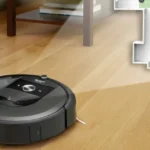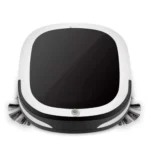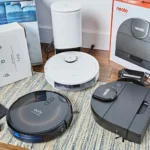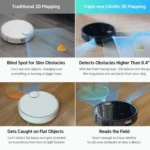Picture a world where you never have to worry about cleaning your floors ever again. Smart vacuum cleaners have made this a reality. But have you ever wondered how these machines know when to stop or turn around when encountering obstacles in their path? The answer lies in advanced sensors and technologies used for obstacle detection in smart vacuum cleaners. This article will take a deep dive into the various types of sensors and smart technologies used to make these machine’s ‘see’ and navigate around their surroundings. So, let’s explore this fascinating world of obstacle detection!
Types of Sensors Used in Smart Vacuum Cleaners
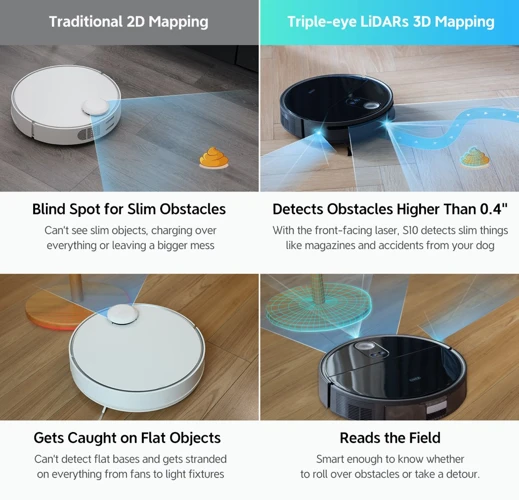
As smart vacuum cleaners become increasingly popular, the need for accurate and efficient obstacle detection technology has become essential. This technology relies on an array of sensors that can detect obstacles in the path of the vacuum, enabling it to navigate around them and clean the surrounding areas effectively. Different sensors offer unique benefits and capabilities, and in this section, we will dive into the most commonly used sensors in smart vacuum cleaners. Understanding these sensors is essential to comprehend the obstacle detection mechanism of smart vacuum cleaners.
Infrared Sensors
Advanced sensors and technologies play a crucial role in the obstacle detection capabilities of smart vacuum cleaners. Infrared sensors are among the most common types of sensors used for this purpose. These sensors emit infrared light and detect the reflection of that light off any obstacles in their path. They are typically located on the bottom or sides of the vacuum.
Infrared sensors are highly effective at detecting objects in the vacuum’s path and can help prevent collisions. They work well in detecting objects that are low to the ground, such as furniture legs and baseboards. One of the main advantages of infrared sensors is their low cost compared to other sensors. However, they do have limitations in that they cannot detect objects that are above ground level.
Here is a table summarizing the pros and cons of infrared sensors:
| Pros | Cons |
|---|---|
| Low cost | Cannot detect objects above ground level |
| Effective at detecting low-level objects | |
| Can prevent collisions |
Infrared sensors are a valuable addition to the obstacle detection technology used in smart vacuum cleaners. By combining them with other types of sensors and smart technology, vacuum cleaners can navigate around obstacles with ease and maintain peak performance.
To learn more about the benefits of obstacle detection in smart vacuums, check out this article. You can also read about the impact that obstacle detection technology has on a vacuum cleaner’s performance and find out how it can be integrated into a smart home.
Ultrasonic Sensors
One of the most popular types of sensors used in smart vacuum cleaners for obstacle detection is ultrasonic sensors. These sensors emit high-frequency sound waves which bounce off surrounding objects and return to the vacuum cleaner. By measuring the time it takes for the sound waves to return, the vacuum cleaner can determine the distance and location of obstacles in its path.
- Advantages
- They are highly effective in detecting objects that are smaller in size
- Ultrasonic sensors provide very accurate readings of the distance and location of obstacles
- They can detect obstacles even in the dark
- Disadvantages
- They are not as effective in detecting obstacles that are soft or absorbent
- Ultrasonic sensors are sensitive to temperature changes and can be affected by environmental factors such as humidity
- False readings can occur if there are multiple objects in close proximity to each other
Despite its limitations, ultrasonic sensors are widely used for obstacle detection in smart vacuum cleaners due to their reliability and accuracy. They are typically combined with other sensors, such as infrared and laser scanners, for even more precise obstacle detection.
The integration of advanced sensors and technologies such as ultrasonic sensors in smart vacuum cleaners has greatly improved their obstacle detection capabilities. With the ability to accurately navigate around obstacles, these devices have become must-have household appliances for busy homeowners. To learn more about obstacle detection in vacuum cleaners, check out our article on obstacle detection in vacuum cleaners.
Laser Scanners
Laser scanners are another type of sensors used in smart vacuum cleaners for obstacle detection. These sensors work by emitting a laser beam that reflects off objects and returns to the sensor, providing accurate measurements of distance and location. Laser scanners are highly advanced sensors and are generally found in the most high-end smart vacuum cleaners.
Advantages of Laser Scanners
One of the main advantages of laser scanners is their accuracy. They can provide accurate readings of the distance and location of objects, which allows smart vacuum cleaners to avoid obstacles with precision. Additionally, laser scanners can map the environment around them, creating a detailed map that the vacuum cleaner can use to navigate.
Disadvantages of Laser Scanners
While laser scanners are highly accurate, they can be more expensive than other types of sensors. Additionally, they require a significant amount of processing power to interpret the information they collect. This can make them more challenging to integrate into smart vacuum cleaners, which can impact their affordability.
Examples of Laser Scanning Technology
One example of laser scanning technology in smart vacuum cleaners is the Neato Botvac D7. This vacuum cleaner uses a laser scanner for obstacle detection and mapping. It can create a detailed map of the environment in real-time, allowing it to navigate through the area with precision.
Another example is the iRobot Roomba i7+. This smart vacuum cleaner uses a laser scanner for obstacle detection and mapping as well as virtual wall technology. Using the laser scanner, it can detect and avoid obstacles, while virtual wall technology allows the user to set up boundaries in areas where they don’t want the vacuum cleaner to go.
Laser scanners are highly advanced sensors that are primarily found in high-end smart vacuum cleaners. They offer unparalleled accuracy and mapping capabilities, but can be more expensive to integrate due to their advanced technology.
Cliff Sensors
Cliff sensors are one of the most advanced types of sensors used in smart vacuum cleaners. They detect the presence of gaps, cliffs, or drops in the cleaning path to avoid accidents and damages.
How do Cliff Sensors Work?
Cliff sensors emit infrared light and monitor the reflection of the light waves in order to detect the presence of a drop or a cliff. If the sensor detects that the surface below the vacuum cleaner is beyond its height limit, it immediately stops moving and notifies the user.
Cliff sensors work based on the principle of triangulation. By measuring the angle at which the emitted light returns back to the sensor, the distance between the sensor and the surface below can be calculated.
Advantages of Cliff Sensors
One of the major advantages of cliff sensors is that they provide an extra layer of protection for the vacuum cleaner. They prevent the vacuum cleaner from tumbling down the stairs or falling off the edges of the floors, which can cause damage or even injury.
Another advantage of cliff sensors is their accuracy. They can detect even small drops or gaps in the cleaning path, which makes them highly reliable in avoiding obstacles.
Disadvantages of Cliff Sensors
Despite their accuracy and usefulness, cliff sensors do have some drawbacks. For one, they can be affected by ambient light or shiny surfaces, which can interfere with the infrared readings. Another issue is that they require an unobstructed view of the surface below, which can be a challenge if there are objects or furniture blocking the path.
Comparison with Other Types of Sensors
Compared to other types of sensors, such as laser scanners or camera sensors, cliff sensors are relatively simple and inexpensive. However, they may be less effective in detecting obstacles other than cliffs or drops, such as walls or furniture.
| Features | Cliff Sensors | Laser Scanners | Camera Sensors |
|---|---|---|---|
| Price | Low | High | High |
| Accuracy | High (for cliffs and drops) | High (for obstacles and mapping) | High (for object detection and recognition) |
| Complexity | Low | High | High |
Conclusion
Cliff sensors are an important component of obstacle detection technology in smart vacuum cleaners. They provide a reliable and accurate way of detecting drops and cliffs to prevent accidents and damages. However, they have their limitations and may not be effective in detecting other types of obstacles. When combined with other sensors and technologies, such as laser scanners and mapping software, cliff sensors can help create a more efficient and effective cleaning experience for users.
Smart Technologies Used for Obstacle Detection in Smart Vacuum Cleaners
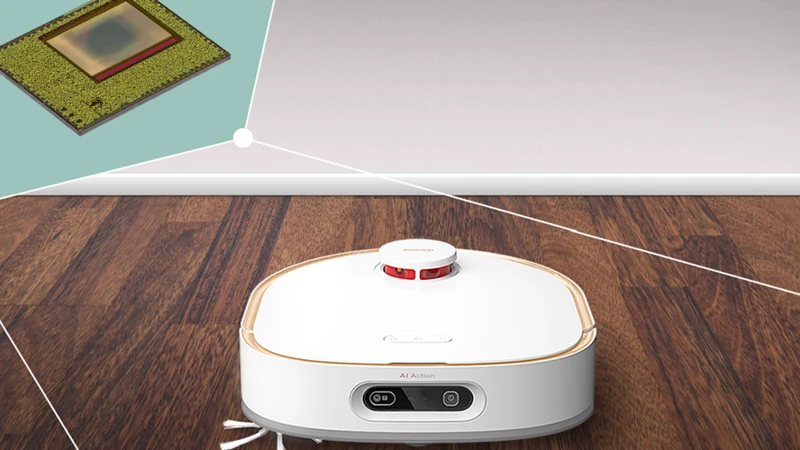
With the advent of smart technology, vacuum cleaners are becoming more intuitive and efficient in performing their intended function. One of the areas where this technology has had an incredible impact is in obstacle detection. Smart technologies have been integrated into vacuum cleaners to make them capable of detecting and avoiding obstacles in their path. In this section, we will explore some of the advanced smart technologies used for obstacle detection in smart vacuum cleaners. These technologies not only improve the performance and efficiency of vacuum cleaners but also enhance their functionality and ease-of-use.
Mapping and Navigation Technology
Smart vacuum cleaners have revolutionized the cleaning industry, thanks to their advanced obstacle detection technology. One of the technologies responsible for this is the mapping and navigation feature. This technology utilizes various sensors to create a map of the cleaning area to enable the device to navigate around obstacles and clean areas more efficiently.
Here’s how mapping and navigation technology works:
- The vacuum cleaner uses sensors such as laser scanners, infrared sensors, ultrasonic sensors, and cliff sensors to detect obstacles in its path.
- The device then maps out the space, creating a virtual representation of the environment being cleaned.
- The map is then used as a guide to enable the vacuum cleaner to navigate around obstacles while ensuring maximum cleaning efficiency.
Mapping and navigation technology helps to make smart vacuum cleaners more intelligent and efficient, especially when cleaning larger areas. It also helps to eliminate the need for constant human intervention during the cleaning process.
Benefits of mapping and navigation technology in smart vacuum cleaners:
- Efficient cleaning: The mapping technology enables the vacuum cleaner to move in a structured pattern, ensuring that it covers every area of the room.
- Customized cleaning: Smart vacuum cleaners can be programmed to clean specific areas, thanks to the mapping technology.
- Convenient cleaning: Mapping technology allows the vacuum cleaner to resume cleaning from where it left off after charging its battery, ensuring that the cleaning process is uninterrupted.
Mapping and navigation technology is a game-changer in the smart vacuum cleaning industry. Its ability to create maps and provide efficient cleaning helps to make cleaning less of a chore and more convenient.
Artificial Intelligence
One of the revolutionary advancements in smart vacuum cleaner technology is the use of artificial intelligence for obstacle detection. AI is a cutting-edge technological solution that incorporates algorithms and machine learning processes to create more intelligent devices that can improve efficiency, functionality, and ease-of-use.
AI-powered smart vacuum cleaners have the ability to learn while in operation, using neural networks that facilitate the interaction between sensors and the navigation system. This means that the device will become more adept at identifying and avoiding obstacles over time. By using machine learning and data-driven decision-making, AI can help smart vacuums navigate complex and cluttered environments with greater precision and ease.
To further illustrate the capabilities of AI, let us look at the following table which describes some of the advantages of using AI for obstacle detection in smart vacuum cleaners.
| Advantages of AI for Obstacle Detection | Description |
|---|---|
| Enhanced Obstacle Detection | AI-powered smart vacuum cleaners use machine learning and neural networks to analyze and identify various types of obstacles, including furniture, walls, and other objects that may be in their path. This helps to prevent collisions and ensure efficient cleaning. |
| Improved Navigation | The use of AI technology in smart vacuums enables the device to create a detailed map of the environment and learn the layout of obstacles over time. This means that the technology can be used to plan more efficient cleaning routes, saving time and energy. |
| Customized Cleaning | AI-powered smart vacuums can adapt to the layout of a specific room, learning which areas require more attention and adjusting their cleaning schedule accordingly. |
| Real-time Decision Making | By incorporating AI technology, smart vacuum cleaners can make real-time decisions on how to navigate obstacles and avoid collisions without needing human intervention. |
| Energy Savings | Smart vacuums that use AI for obstacle detection can optimize their cleaning routes, reducing the need for additional energy consumption. |
| Increased Efficiency | By using AI technology, smart vacuums can clean more efficiently, adapting to obstacles with greater ease and navigating their environment with greater precision. This can lead to more efficient and effective cleaning in less time. |
Artificial intelligence has the potential to revolutionize how smart vacuum cleaners approach obstacle detection. By learning, adapting, and optimizing their cleaning tasks over time, AI-powered devices can overcome the technological limitations of traditional sensors and provide enhanced performance, efficiency, and functionality.
Wheel Tracking
Smart vacuum cleaners are equipped with advanced technologies to perform their cleaning tasks with efficiency and ease. One such technology is wheel tracking, which allows the device to navigate around obstacles and continue cleaning without any interruption. Wheel tracking works by using sensors placed on the wheels of the vacuum cleaner to detect changes in speed and direction. The data collected by the sensors is then used to adjust the vacuum’s movements to avoid obstacles and cover a wider area.
A key advantage of wheel tracking is that it enables the smart vacuum cleaner to map and navigate a room more accurately. By tracking the movement of the wheels, the device can detect when it needs to change direction or speed to avoid obstacles such as furniture legs, walls, and other objects. This helps to prevent collisions that could damage the vacuum cleaner or the furniture it is cleaning around.
To implement this technology, smart vacuum cleaners often use a combination of sensors, including accelerometers, gyroscopes, and motor encoders. These sensors work together to provide precise information about the vacuum’s movement and orientation, allowing it to navigate around objects with greater accuracy.
Below is an html table that shows the different types of sensors used for wheel tracking in smart vacuum cleaners:
| Accelerometers | Detect changes in velocity |
| Gyroscopes | Detect changes in orientation |
| Motor Encoders | Measure the rotation of the wheels |
Overall, wheel tracking is an essential aspect of obstacle detection technology in smart vacuum cleaners. By allowing the device to navigate seamlessly around a room, it ensures that every corner and crevice is cleaned thoroughly without any hiccups. This not only enhances the vacuum’s performance but also improves its efficiency and battery life. It’s just one of the many technologies that allow smart vacuum cleaners to work smarter, not harder.
Camera Sensors
Camera sensors are becoming increasingly popular in smart vacuum cleaners for obstacle detection. They work by taking photos of the environment, converting them into digital signals, and then using sophisticated algorithms to detect obstacles.
Advantages of Camera Sensors:
| Advantages | Description |
|---|---|
| Accurate Detection | The camera can detect even small obstacles or changes in the environment. |
| Real-time Data | Camera sensors provide live images that can be analyzed in real-time to adjust the vacuum cleaner’s path and avoid collisions. |
| Versatile | Camera sensors can detect a wide range of obstacles, including furniture, toys, and even pets. |
How Camera Sensors Work:
The camera sensors in smart vacuum cleaners consist of a small camera that takes photos in rapid succession, similar to how a digital camera functions. These images are then analyzed by sophisticated algorithms that detect changes in the environment and locate obstacles.
The software used in camera sensors is highly advanced, and it can distinguish between different types of objects and surfaces. For example, it can differentiate between a solid object and a shadow, which helps the vacuum cleaner to avoid collisions with the wall.
Camera sensors are especially useful in larger homes or commercial settings, where there are many obstacles in the environment. They provide a reliable and efficient way to detect obstacles, which helps to keep the vacuum cleaner on track and prevents it from getting stuck.
Challenges with Camera Sensors:
While camera sensors are highly effective, there are some challenges associated with their use. One of the primary challenges is the need for adequate lighting. Dimly lit environments can interfere with the accuracy of the camera’s detection, which can result in collisions or other problems.
Another challenge is the need for regular cleaning of the camera’s lens. If dust or debris accumulates on the lens, it can interfere with the camera’s image capture and analysis, affecting its accuracy.
Despite these challenges, camera sensors are rapidly becoming a popular choice in smart vacuum cleaner technology, and their use is expected to grow in the coming years. Their reliability, versatility, and accuracy make them an ideal choice for obstacle detection in smart vacuum cleaners.
Virtual Walls
Virtual walls are another technology used in smart vacuum cleaners for obstacle detection. They are an excellent way to keep your vacuum cleaner in check and clean only those areas where you want it to clean. Virtual walls are electronic barriers that use infrared or magnetic signals to define the boundary of a cleaning area. These boundaries can be set up around the entire house, specific rooms or furniture.
Virtual walls are an excellent alternative to physical barriers such as gates and fences as they are less intrusive and can be configured quickly. Unlike physical barriers, virtual walls can be moved with ease and do not take up space. This technology is particularly useful for those who want to keep their vacuum cleaners away from electrical cords, pet bowls or valuable items.
Some of the most high-end models have built-in sensors that use digital mapping technology to create a virtual map of your home. This map can be used to configure multiple virtual walls and define cleaning zones. Virtual walls can also be set up to send alerts when the vacuum cleaner is outside the boundary that has been set.
Virtual walls are an excellent addition to the technology used in smart vacuum cleaners as they allow for more control and precision over where and how the vacuum cleaner operates. They are versatile and can be used in a variety of settings, including homes with pets, small children and valuable items.
Table:
| Advantages of Virtual Walls in Smart Vacuum Cleaners | Disadvantages of Virtual Walls in Smart Vacuum Cleaners |
|---|---|
| Electronic barriers can be set up quickly and easily. | Only available in high-end models of smart vacuum cleaners, making cost a barrier for some consumers. |
| Virtual walls take up no space and are not obtrusive. | The signal may weaken over time and need to be reset. |
| Virtual walls can be reconfigured and moved with ease. | May not be effective in areas with high foot traffic. |
| Can be used to keep vacuum cleaners away from valuable items and furniture. | May not work as effectively in areas with objects that reflect or absorb infrared signals. |
Virtual walls are a powerful technology that allows for optimal control over the cleaning process when using a smart vacuum cleaner. While they may not be perfect, the advantages of virtual walls far outweigh the disadvantages, especially for individuals who are concerned about protecting valuable items or maintaining a clean home in crowded or difficult-to-reach spaces.
How Obstacle Detection Technology Impacts Smart Vacuum Cleaners
As smart home technology continues to evolve, the impact of obstacle detection technology on smart vacuum cleaners cannot be overstated. With advanced sensors and smart technologies at their disposal, these sleek gadgets can now effortlessly navigate around obstacles, ensuring that every inch of the floor cleaning task is completed with utmost precision. In this section, we will delve into the far-reaching effects of obstacle detection technology on smart vacuum cleaners. From improved performance and efficiency to enhanced safety and security, we’ll explore how smart vacuum cleaners are benefiting from these advancements.
Improved Performance
One of the most significant advantages of utilizing advanced sensors and technologies for obstacle detection in smart vacuum cleaners is the improved performance it offers. With the ability to detect and avoid obstacles, smart vacuum cleaners can operate with greater efficiency and thoroughness, providing a superior cleaning experience.
Let’s take a closer look at how obstacle detection technology impacts performance:
| Improved Performance: | Explanation: |
|---|---|
| Effective Cleaning | Advanced sensors and technologies used in smart vacuum cleaners can detect obstacles, map out areas and ensure that all surfaces are cleaned thoroughly, leaving no dirt or debris behind. |
| Efficient Cleaning | Smart vacuum cleaners consume less power compared to conventional vacuum cleaners, as they only clean specific areas or rooms likely to be soiled, Thanks to obstacle detection technology. |
| Easy Navigation | Obstacle detection sensors and technologies make it more manageable for the smart vacuum cleaner to navigate tight spaces and maneuver around furniture, reducing chances of impact and damage to your belongings. |
| Automated Cleaning | Smart vacuum cleaners can scan their surroundings and detect obstacles in their path. Once detected, the vacuum will either avoid the obstacle or adjust its path to clean around it, contributing to a fully automated cleaning experience. |
In essence, the inclusion of advanced sensors and technologies for obstacle detection enables smart vacuum cleaners to clean more efficiently, navigate more effectively and ultimately provide a much better cleaning experience for the user. Combining obstacle detection technology with other complementary technologies like mapping, navigation, and Artificial Intelligence takes the cleaning experience a notch higher, presenting a technology-driven approach that revolutionizes the way we clean our spaces.
Efficiency and Battery Life
The use of advanced sensors and technologies has transformed traditional vacuum cleaners into smart vacuum cleaners with obstacle detection capabilities. Improved efficiency and battery life are some of the significant advantages of using these smart vacuum cleaners. Let’s take a closer look at how technology impacts these factors.
One of the most important aspects of a vacuum cleaner’s efficiency is its suction power. Smart vacuum cleaners utilize advanced sensors to detect obstacles in their path, such as furniture or carpets. When the sensors detect these obstacles, the vacuum cleaner’s suction power is automatically adjusted to provide optimal cleaning without wasting energy. This feature not only improves the device’s efficiency but also helps to extend its battery life.
In addition to the sensor technology, modern smart vacuum cleaners also have advanced battery systems that enable them to clean larger areas than traditional vacuum cleaners. The batteries are designed to last longer and recharge faster, making it easier to clean the entire house without worrying about running out of power. This feature saves time and effort and makes the vacuuming task much more convenient.
To help illustrate the impact of technology on efficiency and battery life, we have compiled the data provided by two of the most popular smart vacuum cleaners in the market, the Roomba i7, and the Shark IQ Robot Self-Empty. The table below summarizes the battery life and efficiency of these vacuum cleaners.
| Vacuum Cleaner | Battery Life | Efficiency |
|---|---|---|
| Roomba i7 | Up to 120 minutes | 10X suction power |
| Shark IQ Robot Self-Empty | Up to 90 minutes | Self-cleaning brush roll |
Both the Roomba i7 and Shark IQ Robot Self-Empty have advanced sensors and technologies that help them to detect obstacles and optimize their efficiency. As can be seen in the table, the Roomba i7 has a longer battery life of up to 120 minutes, while the Shark IQ Robot Self-Empty has a self-cleaning brush roll feature that further improves efficiency.
Using advanced sensors and technologies for obstacle detection in smart vacuum cleaners has significantly impacted their efficiency and battery life. These features help to reduce energy wastage, extend battery life, and make vacuuming more convenient and comfortable for users.
Functionality and Ease-of-Use
When it comes to smart vacuum cleaners, functionality and ease-of-use are critical factors. Thanks to advanced obstacle detection sensors and technologies, smart vacuums are now more functional and user-friendly than ever before. Let’s take a closer look at how these technologies impact the functionality and ease-of-use of modern smart vacuum cleaners.
One of the primary ways in which advanced obstacle detection technology impacts functionality and ease-of-use is through improved navigation. Smart vacuums equipped with mapping and navigation technology can create detailed maps of your home, allowing them to navigate more efficiently and accurately. This means fewer missed spots and more thorough cleaning overall. With the use of artificial intelligence, these vacuums can learn from past cleaning experiences and adjust their cleaning strategies accordingly, providing even more efficient cleaning the more they’re used.
Another way in which obstacle detection technology improves functionality and ease-of-use is through the use of virtual walls, which help keep the vacuum within its designated cleaning area. By placing virtual barriers around objects, rooms, or areas where you don’t want the vacuum to go, you can ensure that it stays within the confines of the area you want it to clean.
Wheel tracking technology helps to keep the vacuum on track and avoid getting stuck. Through wheel tracking, the vacuum can detect when it’s veering off course, and make adjustments to its navigation accordingly. This prevents the vacuum from getting stuck or lost, and ensures that it follows its designated cleaning path.
Lastly, camera sensors provide an extra layer of functionality and ease-of-use to smart vacuums. With the addition of camera sensors, the vacuum can detect and avoid small objects or obstacles that it might otherwise miss with other types of sensors. This means fewer collisions and better overall performance.
All of these obstacle detection technologies work together to improve the functionality and usability of smart vacuum cleaners, making them more intuitive and convenient to use.%md### Table on how advanced obstacle detection technology improves functionality and ease-of-use
| Obstacle Detection Technology | Benefits for Functionality and Ease-of-Use |
| Mapping and Navigation Technology | Creates detailed maps of your home for more efficient and accurate cleaning |
| Artificial Intelligence | Learns from past cleaning experiences for even more efficient cleaning |
| Virtual Walls | Helps keep the vacuum within designated cleaning area |
| Wheel Tracking | Prevents vacuum from getting stuck or lost |
| Camera Sensors | Detects small objects and obstacles for better overall performance |
Enhanced Safety and Security
Advanced obstacle detection technology has become an indispensable part of modern smart vacuum cleaners, not only for improved performance and efficiency but also for enhanced safety and security. To understand the benefits of obstacle detection in terms of safety and security, let’s take a closer look at how different sensors and technologies work together to make smart vacuums safer and more secure.
| Sensor/Technology | How it Works | Benefits for Safety and Security |
| — | — | — |
| Cliff Sensors | Detects sudden drops or cliffs | Prevents the vacuum from falling down stairs or damaging furniture |
| Infrared Sensors | Detects objects in front of the vacuum | Avoids collisions with obstacles and pets |
| Ultrasonic Sensors | Sends high-frequency sound waves to detect objects | Avoids collisions with small, hard-to-see objects and detects the distance between objects and the vacuum |
| Laser Scanners | Scans the surrounding environment to create a 360-degree map | Helps the vacuum navigate through obstacles and creates more accurate cleaning plans |
| Camera Sensors | Records real-time video footage | Enables remote monitoring of homes and improved surveillance options |
| Virtual Walls | Sets up invisible barriers | Prevents the vacuum from entering restricted areas or moving through doorways when desired |
When these sensors and technologies work together, they create a safer and more secure cleaning environment. The vacuums are designed to avoid collisions and prevent damage to objects, pets, and furniture. Additionally, advanced mapping and navigation technology enables the vacuum to navigate in a more precise and efficient manner, reducing the likelihood of accidents.
Advanced obstacle detection technology contributes to the security of a home by enabling remote monitoring through the use of camera sensors. Not only do homeowners have the freedom to monitor their homes from anywhere, but they can also set up virtual walls to restrict the vacuum’s movements and prevent it from entering specific rooms or areas.
Advanced obstacle detection technology is no longer just a luxury feature in smart vacuum cleaners – it’s now a necessity. With the seamless integration of different sensors and technologies, vacuums are becoming safer, more efficient, and more convenient for homeowners.
Conclusion
In today’s fast-paced world, where time is of the essence, smart technology has become a blessing in disguise for people from all walks of life. Smart vacuum cleaners are no exception to this trend, as they have made cleaning a breeze for homeowners worldwide. The advanced sensors and technologies used for obstacle detection in smart vacuum cleaners are nothing short of a game-changer in the cleaning industry.
With the use of infrared sensors, ultrasonic sensors, laser scanners, and cliff sensors, smart vacuum cleaners can detect obstacles in their path, ensuring thorough cleaning without any interruptions or accidents. Mapping and navigation technology, artificial intelligence, wheel tracking, camera sensors, and virtual walls further enhance their obstacle detection capabilities.
The impact of these obstacle detection technologies is clear. Smart vacuum cleaners equipped with them not only improve cleaning performance and efficiency but also offer advanced features and ease of use for homeowners. Furthermore, the enhanced safety and security features ensure a worry-free cleaning experience.
In conclusion, smart vacuum cleaners have come a long way since their inception, thanks to the advanced obstacle detection technologies used in them. With their impressive performance, efficiency, functionality, and ease-of-use, it’s not difficult to see why they have become a household staple worldwide. As technology continues to evolve, one can only imagine what new and exciting features will be integrated into these smart cleaning devices in the future.
Frequently Asked Questions
What are the benefits of using obstacle detection technology in smart vacuum cleaners?
Obstacle detection technology in smart vacuum cleaners enhances performance, improves efficiency and battery life, increases functionality and ease-of-use, and improves safety and security.
What types of sensors are commonly used in smart vacuum cleaners for obstacle detection?
The most commonly used sensors for obstacle detection in smart vacuum cleaners are infrared sensors, ultrasonic sensors, laser scanners, and cliff sensors.
What is the function of infrared sensors in obstacle detection?
Infrared sensors detect the presence of obstacles by emitting and receiving infrared radiation, which is reflected back to the sensor by the obstacle. The sensor then uses this information to determine the presence and location of the obstacle.
What is the function of ultrasonic sensors in obstacle detection?
Ultrasonic sensors use high frequency sound waves to detect the presence and location of obstacles. The sensor emits sound waves and measures the time it takes for the waves to bounce back off of an obstacle.
What is the function of laser scanners in obstacle detection?
Laser scanners project a laser beam onto the environment and measure the time it takes for the beam to reflect off of objects back to the sensor. This information is then used to create a 3D map of the environment.
What are cliff sensors and how do they work?
Cliff sensors detect changes in height, such as a drop-off or stairway, by emitting and receiving infrared or sound waves. The sensor then uses this information to avoid falling off the edge.
What is mapping and navigation technology used for in smart vacuum cleaners?
Mapping and navigation technology is used to create a digital map of the environment, which the smart vacuum cleaner uses to navigate and avoid obstacles.
What is artificial intelligence and how is it used in smart vacuum cleaners?
Artificial intelligence is the ability of a computer system to learn and adapt to new situations. It is used in smart vacuum cleaners to improve obstacle detection, mapping and navigation, and overall performance.
What are virtual walls and how are they used in smart vacuum cleaners?
Virtual walls are a barrier created by the smart vacuum cleaner using sensors and software to create a boundary that the vacuum will not cross. This can be used to keep the vacuum from entering certain areas or rooms.
How does obstacle detection technology impact the overall performance of smart vacuum cleaners?
Obstacle detection technology improves the overall performance of smart vacuum cleaners by allowing them to navigate and clean the environment more efficiently and effectively.

